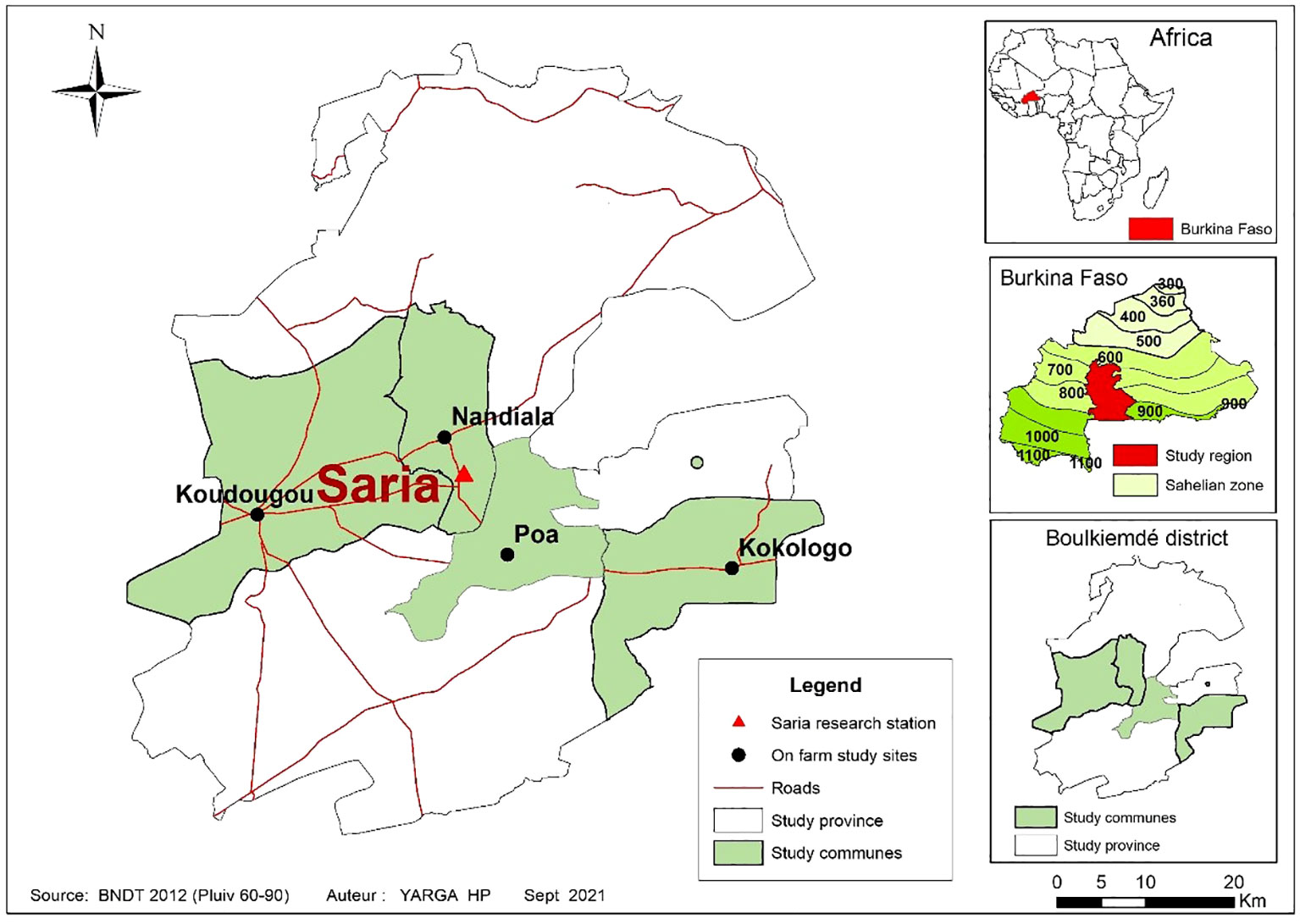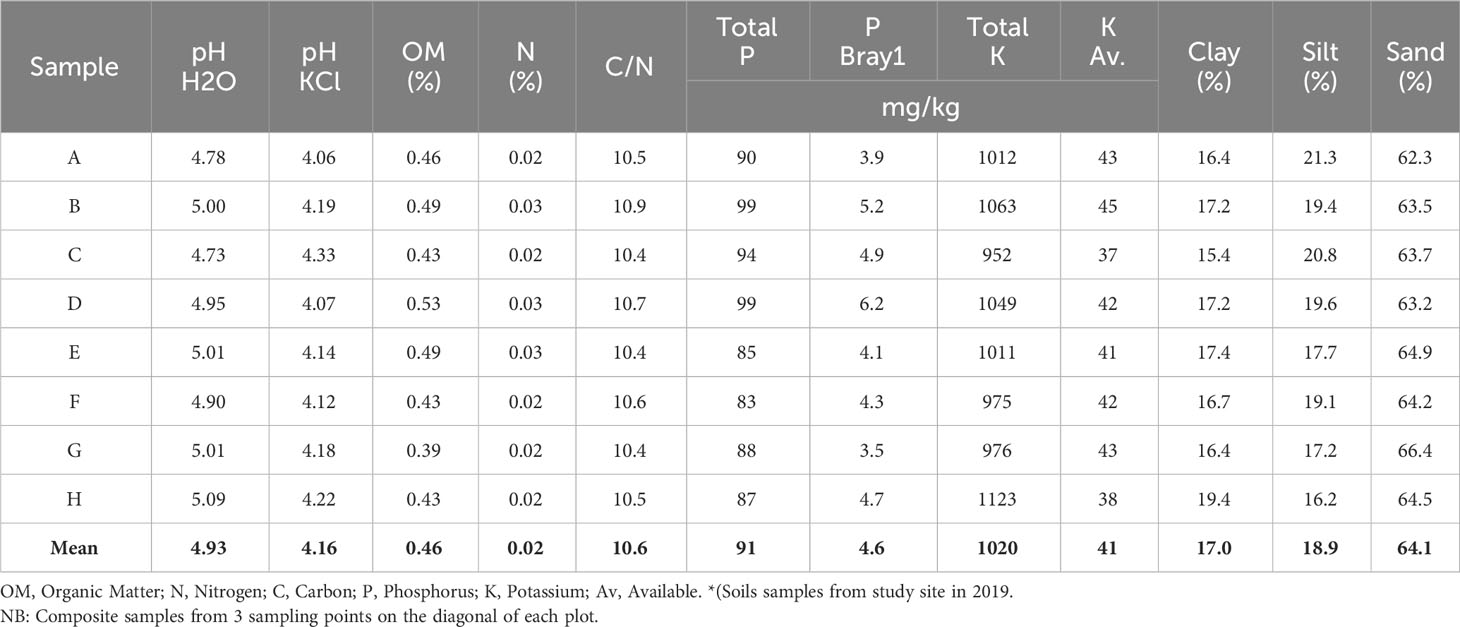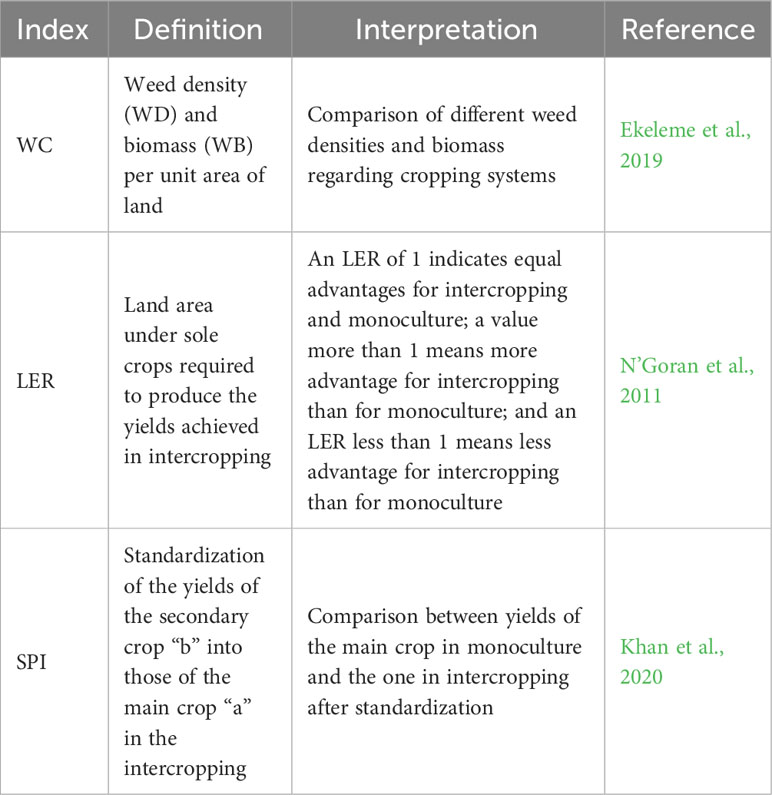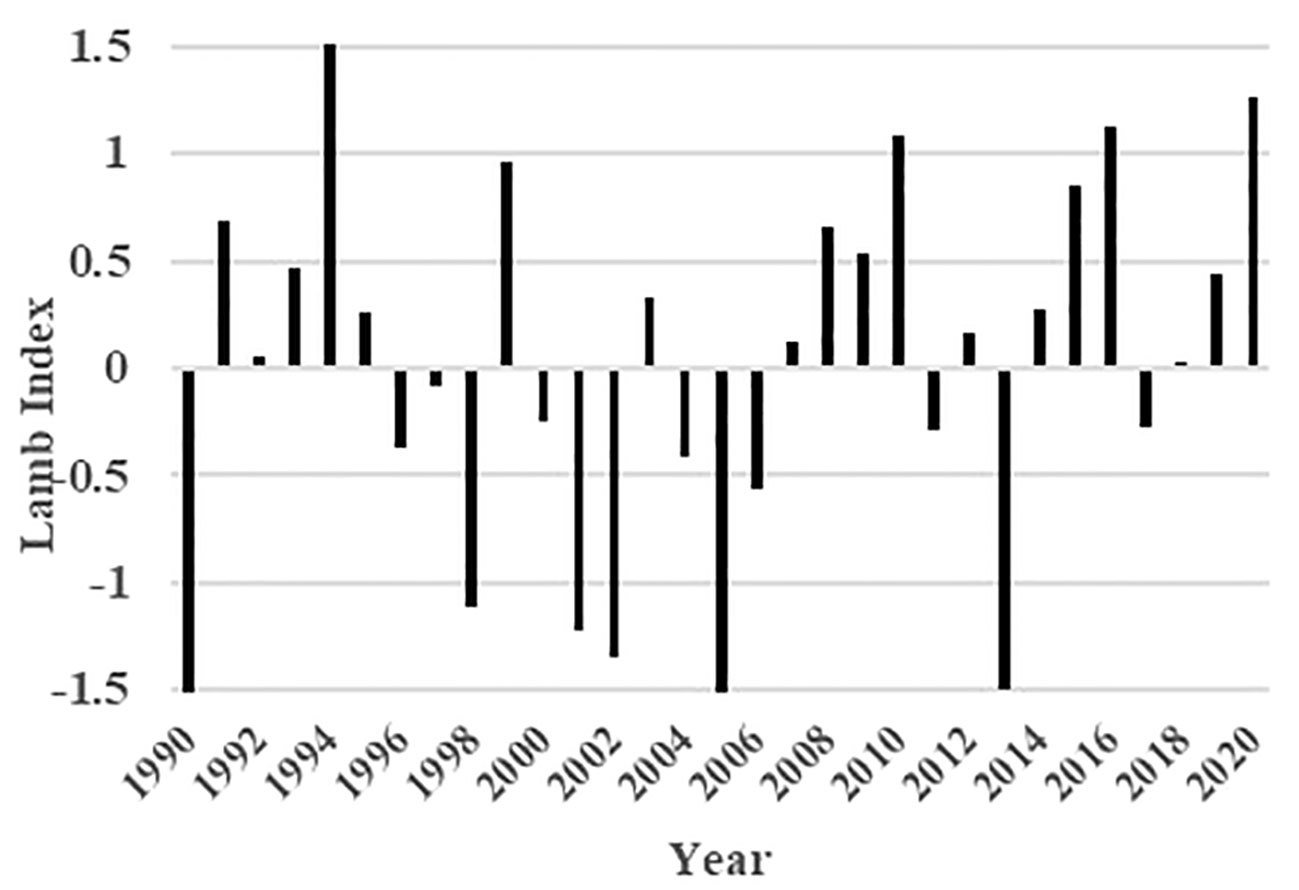Sorghum [Sorghum bicolor (L.) Moench] and cowpea [Vigna unguiculata (L.) Walpers] intercropping improves grain yield, fodder biomass, and nutritive value
- 1Centre National de Recherche Scientifique et Technologique, Institut de l’Environnement et de Recherches Agricoles, Station de Farako-Ba, Bobo-Dioulasso, Burkina Faso
- 2Université de Lomé, Ecole Supérieure d’Agronomie, Lomé, Togo
- 3Agronomy Department, Institute of Food and Agricultural Sciences (IFAS), University of Florida, Gainesville, FL, United States
- 4Feed the Future Innovation Lab for Livestock Systems, Department of Animal Sciences, Institute of Food and Agricultural Sciences (IFAS), University of Florida, Gainesville, FL, United States
Burkina Faso livestock feeding is characterized by a hot dry season fodder deficit, which affects animal performance and causes economic losses. To overcome this challenge, improving quality fodder production through the use of dual-purpose crops is a potential alternative. Hence, this study aimed at testing dual-purpose cultivars of sorghum and cowpea under monoculture and intercropping in the North Sudan zone in Burkina Faso. To do this, a “Mother and Baby trials” approach was adopted. The mother trial was designed as a randomized complete block with eight treatments (combinations of monoculture and intercropping systems for two cowpeas and two sorghum cultivars) and four replications during two cropping seasons (2019 and 2020) at the INERA research station in Saria. The on-farm “baby” trials involved 30 farmers during two cropping seasons (2019 and 2020) in four communes: Koudougou, Poa, Nandiala, and Kokologo. Data were collected on weed biomass and density, fodder biomass and grain yield, intercropping efficiency, and fodder nutritive value. The results of the mother trial showed that intercropping significantly (p ≤ 0.05) reduced weed density and weed biomass. Sorghum cultivar Ponta Negra had the highest fodder biomass yield (10.05 kg DM/ha) while sorghum Sariaso16 had the highest grain yield (4.42 kg/ha). Cowpea cultivar KVx745-11P had greater fodder biomass (4.72 kg DM/ha) than Tiligré (3.28 kg DM/ha) with similar grain yield (2.17 and 2.17 kg/ha). Intercropping was the most efficient land-use cropping system for fodder biomass and grain yield improvement both in mother and baby trials. For fodder nutritive value, cultivars Sariaso16 and Ponta Negra had similar crude protein concentrations (ranging from 4.1 to 5.4%), and cowpea cultivar KVx745-11P haulms had greater crude protein (ranging from 16.9 to 20.3%). The use of Ponta Negra and KVx745-11P and Sariaso16 and KVx745-11P under intercropping is likely to optimize grain and quality fodder production for crop-livestock farmers in the North Sudan zone.
1 Introduction
Three main livestock systems used in Burkina Faso for ruminant production include extensive, semi-intensive, and intensive systems (Kristjanson et al., 2012). Local breeds of cattle (Bos taurus), sheep (Ovis aries), and goats (Capra hircus) are the dominant species. The semi-intensive system involves crop-livestock integration, which includes agro-pastoralists, sedentary crop-livestock farmers, and some peri-urban dairy farmers, and it is the most dominant system (MRA, 2015). In this system, livestock do not move too far from the production site because of the use of manure for soil fertility management and crop residues as livestock feed. Animals are grazed on natural pastures with a little feed complementation during the hot dry season using stored fodder such as legume haulms and cereal straws (Kiéma et al., 2019). The crop-livestock system enhances farmers’ resilience to environmental risks and reduces conflicts for the use of natural resources (FAO, 2014; Sanfo et al., 2015; Kiéma et al., 2019).
The availability of feed resources in the hot dry season is the main constraint of this livestock system. The distances traveled for pasture by livestock are becoming longer because of the decline in pasture productivity and larger livestock herds (Boote et al., 2021). This induces a systematic use of crop residues as feed (Zampaligré et al., 2013; Amole & Ayantunde, 2016; Duncan et al., 2016). These crop residues are either directly grazed on farms after grain harvest or are collected and stored for later use during the hot dry season (Sanou et al., 2011; Cuvelier & Dufrasne, 2014; FAO, 2014; Kiéma et al., 2019). Cereal straw (sorghum [Sorghum bicolor (L.) Moench], millet [Pennisetum glaucum (L.) R. Br.], and maize [Zea mays L)] have low crude protein concentrations (2-9%) compared to legume haulms such as cowpea [Vigna unguiculata (L.) Walpers], groundnut [Arachis hypogaea L], and Bambara bean [Vigna subterranea (L.) Verdc.] (Nantoumé et al., 2000; Palé, 2017; Zampaligré et al., 2021). The use of cereal straw and legume haulms respectively at 40% straw and 10 to 60% legume haulm in local and hybrid sheep diets provided a daily weight body gain of 92 to 206 g/day (Somda, 2001; Kiéma, 2008).
Forage crop production for livestock feed has been sparsely adopted by farmers despite the efforts of extension and research (Bayala et al., 2014; Boote et al., 2021). This reflects the lack of farmers’ interest in those forages due to land tenure, cropping calendar, lack of technical skills, and seed availability issues (Kagoné, 2001; Bayala et al., 2014). Urbanization and demographic pressure on croplands favor food-feed cereal and legume cropping to the detriment of strict forages. This risk management strategy for small crop-livestock farmers benefits from crop residues as livestock feed and grains for food using the same unit of area (Sanfo et al., 2015). The majority of these crop residues used by farmers are from local cultivars with low nutritive value, in addition to their poor preservation causing a loss of nutritive value over time (Feyissa et al., 2014; Akakpo et al., 2020). Research on crop breeding has enabled improved food-feed cultivars that have good grain yield and fodder biomass with better quality (Cesar and Guiro, 2004). A recent study by Zampaligré et al. (2021) identified Sariaso16 for Sorghum and KVX74511P for cowpea to be among the best bet food-feed cultivars for Burkina Faso’s different agro-ecologies. Their introduction of appropriate cropping systems among the smallholder farmers is key for their adoption. Due to a lack of land area and poor soil fertility, smallholder farmers are increasing the use of intercropping of legumes and cereals for their crop production.
Intercropping is an arrangement of crops on the same plot and at the same time for complementarity in order to make the system more resilient to physico-chemical soil conditions (Matusso et al., 2014). Cereal and legume intercropping is more suitable for agro-pastoralists and sedentary crop-livestock farmers because of this dual need for food and feed for human beings and livestock, respectively (Nasir et al., 2019). The use of improved food-feed cultivars, which can fit into smallholder farmer’s cropping calendar, is likely to provide greater benefits both for grains and fodder biomass (Mbaye et al., 2014; Louarn et al., 2016; Abera et al., 2021; Sanfo et al., 2023). Previous studies revealed that intercrop of maize-cowpea-sorghum-cowpea led to an increase in grain yield and fodder biomass in the range of 30-60% with better weed control (Matusso et al., 2014; Obulbiga et al., 2015; Coulibaly et al., 2017; Sanfo et al., 2023), and land equivalent rations were greater in cowpea-maize intercropping systems (Sanfo et al., 2023). Considering the multiple benefits of using improved cultivars and appropriate cropping systems, we hypothesized that intercropping of best-bet sorghum and cowpea cultivars will provide greater grain yield and fodder biomass as well as quality fodder in smallholder farming systems in Burkina Faso. Thus, this study was conducted to assess the agronomic performance and fodder quality of sorghum Sariaso16 and cowpea KVX74511P in intercrop by comparison to monoculture in the crop-livestock system.
2 Materials and methods
2.1 Site description: location, rainfall, soil, vegetation, crop, and livestock systems
The mother study was conducted in Burkina Faso (Figure 1). A central trial was established at INERA (Institut de l’Environnement et de Recherches Agricoles) research station, Saria, located in Boulkiemdé province and Nandiala commune located 80 km southwest of Ouagadougou with coordinates 12° 15′ 57″ N, 2° 08′ 47″ W. On-farm trials were conducted in four other communes, namely, Koudougou, Poa, Nandiala, and Kokologo within 40 km maximum radius from the Saria research station (Figure 1).
The climate is part of the Köppen climate zone B classification (Beck et al., 2018). The annual rainfall is 600-900 mm/year with 6 to 7 months of dry season lasting from November to May, with the rainy season occurring from June to October and the number of rainy days ranging from 60 to 68 a year. The monthly rainfall recorded in 2019 and 2020 in the study site is indicated in Figure 2. The average annual temperature in Saria is approximately 28°C, with a low temperature (12°C) occurring in December-January and a high temperature (40°C) in March-April.
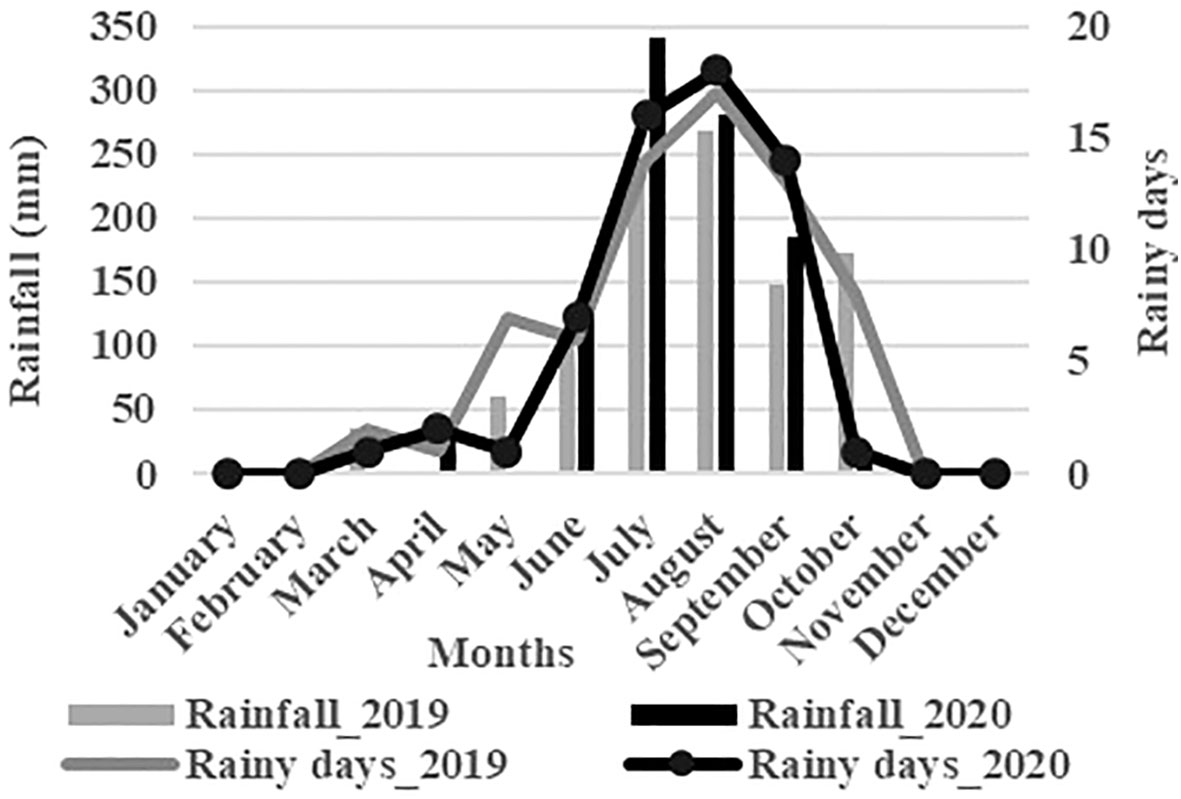
Figure 2 Monthly rainfall recorded in the study site in 2019 and 2020. Source, INERA FARAKOBA Pluviométries de l’année 2019 et 2020.
Soils in the study sites are classified as Ferric Lixisol (Traoré, 2012). They are sandy-silty textured and have acid with low nitrogen, organic matter, available phosphorus, and available potassium contents (Table 1). The vegetation is dominated by agroforestry parklands and annual grasses. Main woody species are Vittelaria paradoxa C.F.Gaertn, Faidherbia albida, Parkia biglobosa Jacq, Tamarindus indica L., Combretum nigricans Lepr, and Piliostigma recticulatum (DC.) Hochst. The dominant grasses are Andropogon gayanus Kunth, Loudecia togoensis Hubb, and Dactyloctenium aegyptium Beauv (Ouédraogo, 2019; Zampaligré et al., 2021).
The cropping system is mainly rain-fed, extensive subsistence agriculture with small farms averaging 2 to 5 ha. It is dominated by cereal-based systems that integrate crops and livestock. The main crops are sorghum for cereals and groundnut and cowpea for legumes, accounting for 61, 69, and 56% of the national area sown for each crop type, respectively (MA, 2015). The dominant livestock systems are the integrated sedentary crop-livestock and agro-pastoral systems with local breeds of cattle, sheep, and goats (Mulumba et al., 2008). The livestock population in this zone is estimated at approximately 11,836,020 for small ruminants and 3,683,125 for large ruminants which represent 50 and 40% of the national flock, respectively (MRA, 2015).
2.2 Methodology
2.2.1 Conceptual framework
This research used the participatory “Mother and Baby trials” approach (Snapp, 2002). It has two steps which are central (Mother) and on-farm (Baby) trials. The central trial is conducted in a village with a leader and innovative farmer or in a nearby research station. On-farm trials are farmers’ individual tests conducted by themselves under the research team’s supervision (Rusike et al., 2004; Gonsalves et al., 2005). Each farmer is a replication and linked to the central trial in order to compare a subset of innovations from the central trial (Snapp, 2002; Gonsalves et al., 2005). This approach allows farmers to evaluate the innovations that are most appropriate for their production system and resource endowment. It is an approach that initiates dialogue and collaboration between farmers, extension workers, policymakers, and researchers. In this way, rapid transformation and dissemination of the innovation are achieved through the snowball effect (Snapp, 2002).
2.2.2 Sampling method and plant materials
In 2018 - 2019, prior to the start of the experiment, a baseline survey with 250 farmers in the same four communes was conducted on fodder production in crop-livestock systems. A reasoned and stratified sampling approach was used regarding these criteria: (i) farmers’ willingness to conduct food-feed trials on at least 0.1 ha, (ii) farm accessibility, (iii) a minimum of three sheep availability for fattening trials, and (iv) gender with at least 30% of women participation. Based on the results of this study, 30 farmers (20 men and 10 women) were selected for a second survey on the evaluation of their preferences for crop species, cultivars, cropping systems, and fodder conservation methods (Sanfo et al., 2020). Following the results of these surveys, the same 30 farmers were chosen for this participatory research on food-feed crop production based on improved cultivars of sorghum and cowpea in intercropping systems.
The choice of cultivars was done according to the farmers’ preferences (Sanfo et al., 2020) and included improved cultivars of sorghum (Sariaso16 and Ponta Negra) and cowpea (KVx745-11P and Tiligré). These cultivars were released by INERA (Institut de l’Environnement et de Recherches Agricoles) and EMBRAPA (Brazil) research. The INERA cultivars are the ones currently being promoted in Burkina Faso (Zampaligré et al., 2021). These cultivars are described in Table 2 (MRSI, 2014; Palé, 2017; Ramdé, 2019; Zampaligré et al., 2021).
2.2.3 Experimental design
The on-station trials were laid out as a completely randomized block design with eight treatments and four replications: two sorghum cultivars, two cowpea cultivars, and two cropping systems (monocultures versus intercropping). The size of each subplot was 35 m² (7 m x 5 m). Below are the treatments:
(T1) Sorghum Ponta Negra only; (T2) Sorghum Sariaso16 only; (T3) Cowpea Tiligré only;
(T4) Cowpea KVx745-11P only; (T5) Sorghum Ponta Negra intercropped with cowpea Tiligré;
(T6) Sorghum Ponta Negra intercropped with cowpea KVx745-11P;
(T7) Sorghum Sariaso16 intercropped with Cowpea Tiligré; and
(T8) Sorghum Sariaso16 intercropped with Cowpea KVx745-11P.
The on-farm trials involved 30 farmers with 0.1 ha as individual plot size. The farmers were all trained on farm agricultural practices and management on 14 and 15 June 2019 at Saria and Kokologo, respectively. Then, they were provided with seed, fertilizer, and pest control products by the research team. Trial implementation was facilitated by a team of extension workers (crop and livestock agents) under the supervision of the research team. Three treatments/options were selected from the on-station trial and tested by 10 farmers per treatment, each farmer representing a replicate for each option:
(T1) Sorghum Sariaso16 only;
(T4) Cowpea KVx745-11P only; and
(T8) Sorghum Sariaso16 intercropped with Cowpea KVx745-11P.
The study was done during two consecutive rainy seasons in 2019 and 2020 on-farm and on-station.
2.2.4 Trial establishment and agronomic management
2.2.4.1 Mother trial established at Saria research station
The trial was implemented on fallow land that had cowpea as the previous crop after soil analysis (Table 1). Flat plowing with a tractor followed by leveling was done after rainfall prior to sowings from 5 to 12 July. These sowings were done manually from 15 to 19 and 18 to 22 July for sorghum in the 2019 and 2020 cropping seasons, respectively. For cowpea, they were done from 25 to 30 July and 28 July to 3 August in 2019 and 2020, respectively. Cowpea sowings were shifted approximately 10 days later from those of sorghum in order to optimize its grain yield and biomass (Mbaye et al., 2014). Spacing was 80 cm between rows and 40 cm between plants within rows for all cultivars. Thinning was done 15-20 days after sowing (DAS) to obtain the needed densities: 62,500 plants/ha for sorghum and cowpea in monocultures plots; and 20 833 plants/ha for cowpea and 41 666 for sorghum in the intercropping plots.
Weeding was done twice (15-20 and 25-35 DAS) followed by hoeing at 40-45 DAS. Cattle manure was applied in the first year at the rate of 5 t/ha before planting. Mineral fertilization was done annually with NPK (14-23-14) at a rate of 100 kg/ha for all sorghum and cowpea crops at 15-20 DAS, corresponding to 14 kg of nitrogen, 10 kg of potassium, and 12 kg of phosphorus (Zampaligré et al., 2021). In addition to NPK, only sorghum plots received 50 kg/ha of urea annually at 40-45 DAS (23 kg of nitrogen). For pest control, two treatments were done on cowpea plots with Acetamiprid16g/l +Indoxacarb 30g/l at the rate of 1 l/ha at flowering and pod formation stages. Sorghum plots were treated specifically with Lambda-cyhalothrin 15 g/l + Acetamiprid 20 g/l against armyworm (Spodoptera frugiperda) attack.
2.2.4.2 On-farm trials (baby trials)
At the on-farm plots, previous crops included cowpea, Bambara bean, millet, and sorghum. Flat plowing with animal traction was done after rainfall followed by sowings. Plantings were done manually by farmers themselves in lines from 14 to 25 July for sorghum and from 22 July to 5 August for cowpea in 2019 and 2020. Planting spacing and thinning were performed following the method described above for the mother trial. Weeding and hoeing were done similarly as in the mother trial.
Mineral fertilization was done annually with NPK (14-23-14) at a rate of 100 kg/ha for all crops at 15 - 20 DAS. In addition to NPK, sorghum plots received 50 kg/ha of urea annually at 40 - 45 DAS. For pest control, two (02) treatments were done on cowpea plots with Acetamiprid16g/l +Indoxacarb 30g/l at the rate of 1 l/ha at flowering and pod formation stages. Sorghum plots were treated specifically with Lambda-cyhalothrin 15 g/l + Acetamiprid 20 g/l against armyworm attack.
2.3 Data collection
2.3.1 Grain yield and fodder biomass evaluation
Grain yield (GY) was evaluated at sorghum panicle and cowpea pod maturity stages using the yield square method in 1m². Three yield squares were placed along the diagonal of each plot; sorghum panicles and cowpea pods were harvested separately and sun-dried for 10 days before being shelled/threshed and winnowed. The obtained grains were further sun-dried to constant weight and then weighed using a small scale (2 kg ± 5 g) to get grain yield for each crop. The fodder biomass was evaluated right after grain harvest (same day) using the same three yield squares. Fresh fodder weight in each square was taken using a 10 kg ± 10 g sensitive scale; a sample of 500 g from each square was collected and oven-dried at 105°C for 24 hours to determine fodder biomass on a dry matter basis (kg DM/ha).
2.3.2 Intercropping efficiency assessment
Three (03) parameters were used to assess the intercropping efficiency: (i) Weed Control (WC) based on Weed Density (WD) and Weed Biomass (WB), (ii) Land Equivalent Ratio (LER), and (iii) System Productivity Index (SPI).
WD was assessed at 70-80 DAS using three (03) yield squares of 1m² in each plot along the diagonal and all weeds within the square were counted.
➢WB was evaluated using the same three yield squares and all the weeds in the square were collected and weighed. Then, samples were oven-dried at 105°C for 24 h. After dry matter determination, weed biomass was calculated by extrapolation (kg DM/ha).
➢LER is the relative land area under sole crops required to produce the yield achieved in intercropping and determined by the following formula (Wiley, 1979 in N’Goran et al., 2011):
Ya and Yb are the yields of sorghum and cowpea in intercropping, respectively. YA and YB are also the yields of sole cultures of sorghum and cowpea on a similar unit area, respectively.
SPI is the standardization of the yields of the secondary crop “b” into those of the main crop “a” in intercropping according to the formula (Agegnehu et al., 2008; Khan et al., 2020): =
Rs and Rc are the average yields of sorghum and cowpea in monoculture, respectively. Ys and Yc are also the average yields of sorghum and cowpea in intercropping, respectively.
The indexes WC, LER, and SPI were used to identify the relative advantages of intercropping, and their appropriate spatial arrangement is described in Table 3.
2.3.3 Fodder nutritive value assessment
Two composite samples of 500 g of the whole plant (stems + leaves) were taken in each plot replication from the three yield squares on the same day of fodder biomass and grain yield assessment. Samples were pre-dried and then shade-dried and ground at 1 mm size. The Near Infrared Spectrometry (NIRS) method was used for nutritive value analysis. Sample spectra were collected using the NIRS FOSS DS 2500 F and the International Livestock Research Institute (ILRI) Global Mixed Feed calibration was used to predict the nutritional quality. Nutritive value parameters assessed were: Dry Matter (DM), ash, Crude Protein (CP), Neutral Detergent Fiber (NDF), Acid Detergent Fiber (ADF), Acid Detergent Lignin (ADL), Metabolizable Energy (ME), and In Vitro Organic Matter Digestibility (IVOMD).
2.4 Data analysis
Data entry as well as tables and graphs were created using Excel. The general linear model of SPSS Statistic 20.0 was used for performing an analysis of variance considering all factors as fixed effects. Three-way ANOVA (year, cultivar, and cropping system) was applied to the on-station trial data and two-way ANOVA (cropping system and year) for on-farm trial data. One-way ANOVA was performed for fodder nutritive value analysis. Mean comparisons for significant effects were done using the LSD (Least Significant Difference) test and significance was declared at p ≤ 0.05%.
3 Results and discussion
3.1 Results
3.1.1 Grain yield, fodder biomass, weed density, and biomass
On-station (mother trial) data analysis of variance (ANOVA) showed that the cultivar effect was significant for fodder biomass, weed density, and biomass of cowpea, while it was only significant for grain yield and fodder biomass of sorghum (Table 4). The cropping system effect was significant for grain yield and fodder biomass for cowpea and sorghum but was significant for only weed density and biomass for sorghum (Table 4).

Table 4 ANOVA results for grain yield, fodder biomass, weeds density, and biomass for cowpea and sorghum (2019 and 2020).
For the on-farm trial, only the cropping system effect was significant for sorghum grain yield and fodder biomass (Table 4).
3.1.2 Cropping systems and weed control
Low weed density (12 plants/m²) and low weed biomass (36.2 kg DM/ha) were obtained with cowpea KVx74511P in monoculture (Table 5). In addition, regardless of sorghum cultivar, weed density and biomass were lower in the intercropping system than in monoculture except for Sariaso16 weed biomass in its intercropping with Tiligré (Table 5).

Table 5 Effect of cropping systems on weeds biomass and density for the mother trial (average of 2019 and 2020).
3.1.3 Grain yield and fodder biomass of tested cultivars
Sorghum Sariaso16 had the greatest grain yield for the on-station trial (4415 kg/ha) and also had a high yield in the on-farm trials (3458 kg/ha) across two rainy seasons (2019 and 2020) (Table 6). Ponte Negra had the highest fodder biomass yield (10051 kg DM/ha). For cowpea cultivars in the on-station trials, KVx745-11P and Tiligré had similar grain yield (2116-2169 kg/ha), while KVx745-11P fodder biomass (4721 kg DM/ha) was higher than Tiligré (3283 kg DM/ha). In the on-station trials, greater fodder biomass was obtained for monoculture of sorghum cultivars compared to intercropping with cowpea. This appeared to repeat for the on-farm trials but was not significant because of large farm-to-farm variability. For intercropping in the on-station trial, the fodder biomass of Ponte Negra was greater than for Sariaso16 regardless of cowpea cultivars used, but Sariaso16 had greater grain yield regardless of cowpea cultivars. For cowpea cultivars tested on-station, grain yield and fodder biomass were greater in monoculture than for intercropping. However, no significant differences were found between the two cultivars for grain yield and fodder biomass in intercropping.
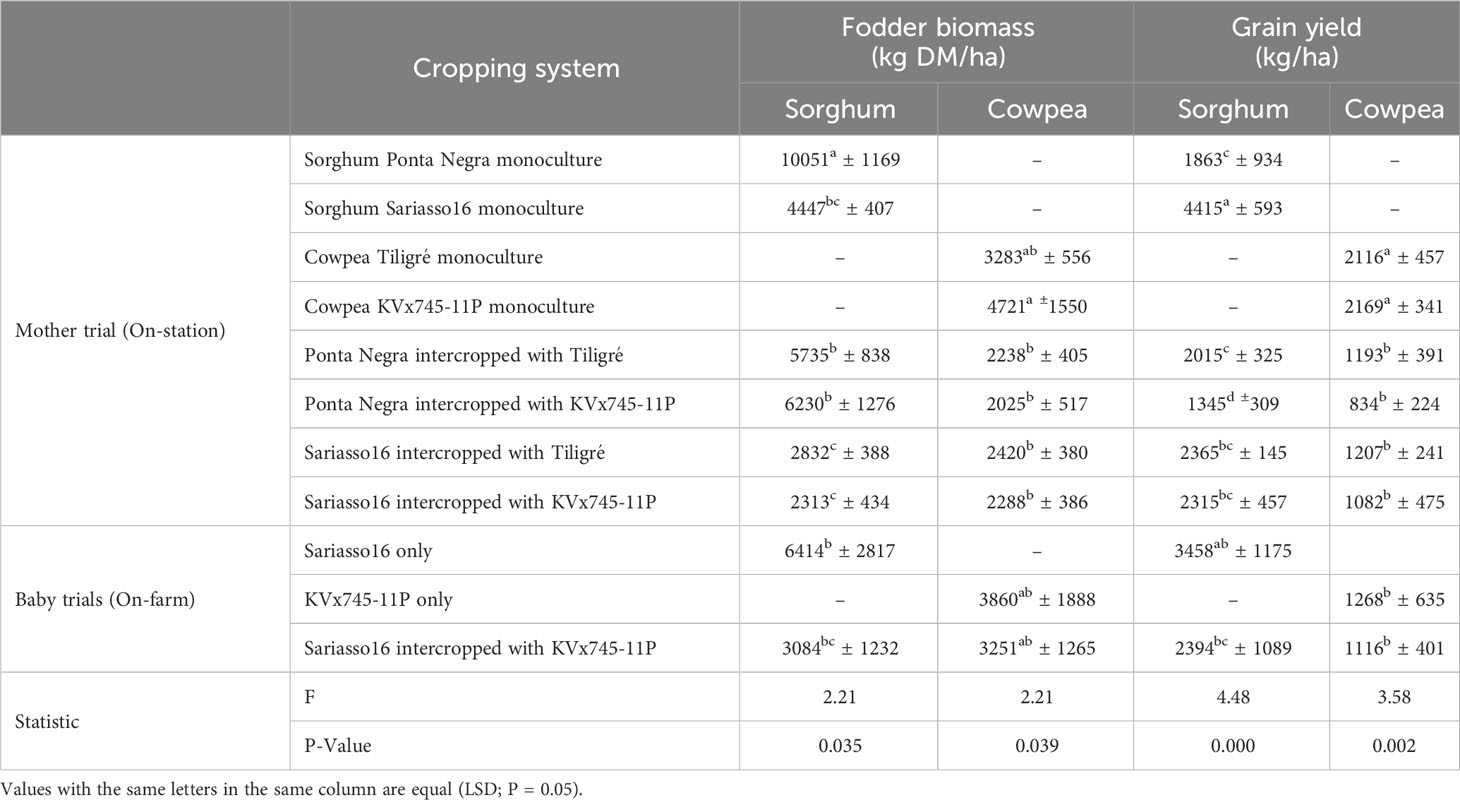
Table 6 Sorghum and cowpea grain yield and fodder biomass regarding the interaction between cropping systems and cultivars across two years.
3.1.4 Intercropping efficiency for land use, grain yield, and fodder biomass
LER and SPI were used to assess land use, grain yield, and fodder biomass efficiencies regarding cropping systems (Table 7). Sorghum and cowpea intercropping LERs for fodder biomass (1.01-1.37) and grain yield (1.02-1.65) were greater than one. Sorghum Sariaso16 intercropped with cowpea Tiligré had the greatest LER for fodder biomass, while the highest LER was obtained for Ponta Negra intercropped with Tiligré for grain yield.
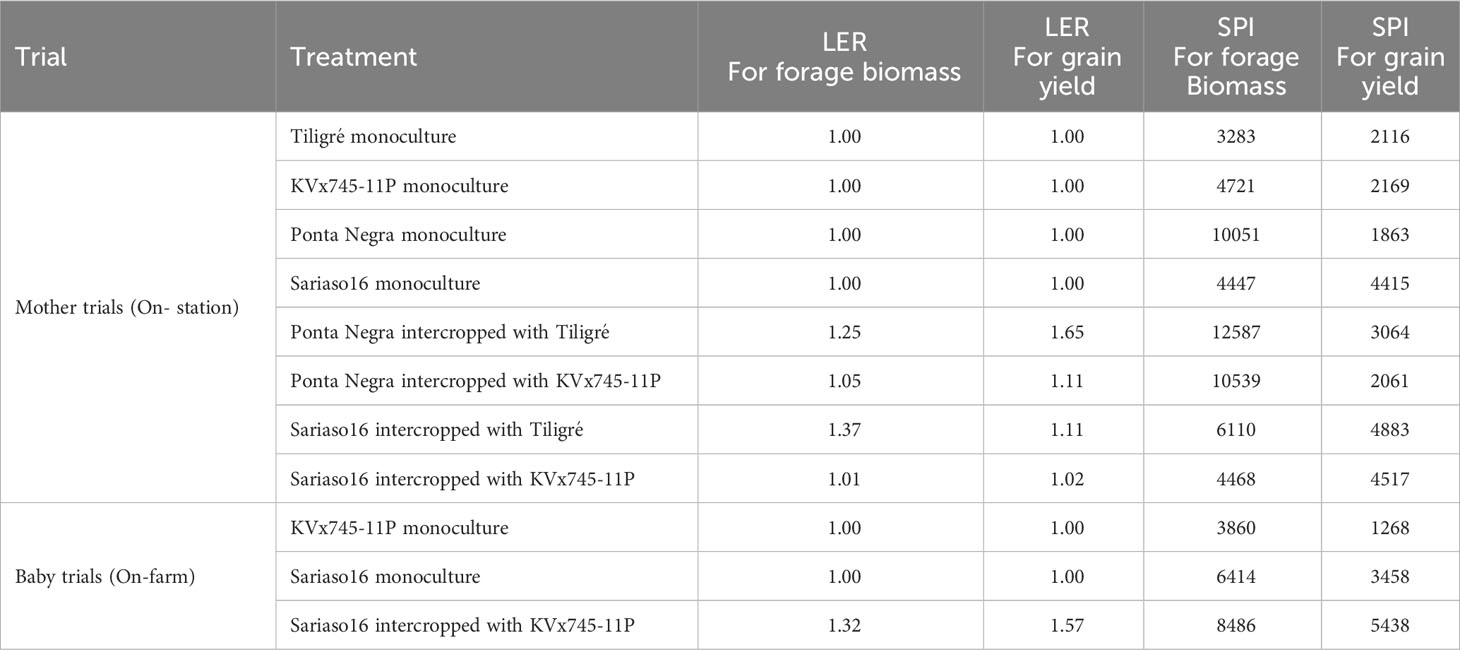
Table 7 Cropping systems System Productivity Index and Land Equivalent Ratio (mother and baby trials).
Intercropping SPIs were higher than those of the corresponding sorghum cultivar (main crop) monoculture evaluated. The highest SPI values for fodder biomass were obtained by Ponta Negra intercropped with either cowpea cultivar (10539 and 12587). In terms of grain yield, Sariaso16 intercropped with cowpea had the highest index (4517 - 5438) regardless of the cowpea cultivar.
3.1.5 Sorghum straw and cowpea haulm nutritive value
Sariaso16 had greater fodder DM, NDF, and ADL, and lower fodder ME and IVOMD compared to Ponta Negra regardless of the cropping system (monoculture and intercropping) and cowpea cultivar used in intercropping (Table 8). Nevertheless, the two sorghum cultivars had similar CP (4.1 – 5.1%) concentrations regardless of the cropping system and cowpea cultivar used in intercropping. There were differences between the nutritive value of sorghum fodder in monoculture and intercropping. Sariaso16 intercropped with cowpea KVx745-11P had lower fodder ADF compared to Sariaso16 in monoculture. Ponta Negra intercropped with Tiligré had greater ME than in monoculture.
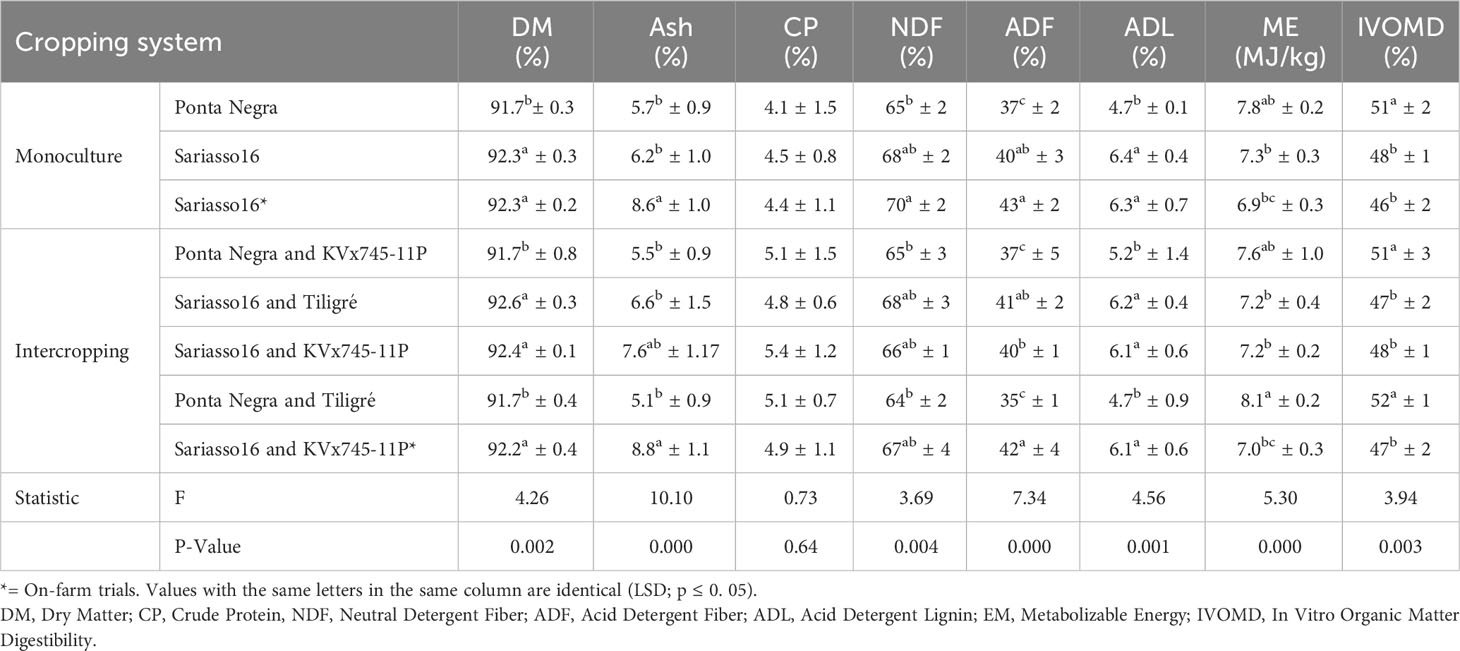
Table 8 Proximate composition and in vitro digestibility of the dry matter of sorghum straws from the mother trial.
Cowpea fodder ME and IVOMD were lower in intercropping than their monoculture regardless of sorghum cultivar used for the intercropping. Cowpea Tiligré fodder ash, ADF, and ADL were greater in intercropping than in monoculture regardless of the companion sorghum cultivar in intercropping (Table 9). Cowpea KVx745-11P intercropped with sorghum Sariaso16 had greater fodder CP than in monoculture, while Tiligré intercropped with Ponta Negra had lower CP compared to monoculture. For cowpea cultivars, KVx745-11P had greater ash (10.6-12.5%) and CP (17-20%) regardless of the cropping system.
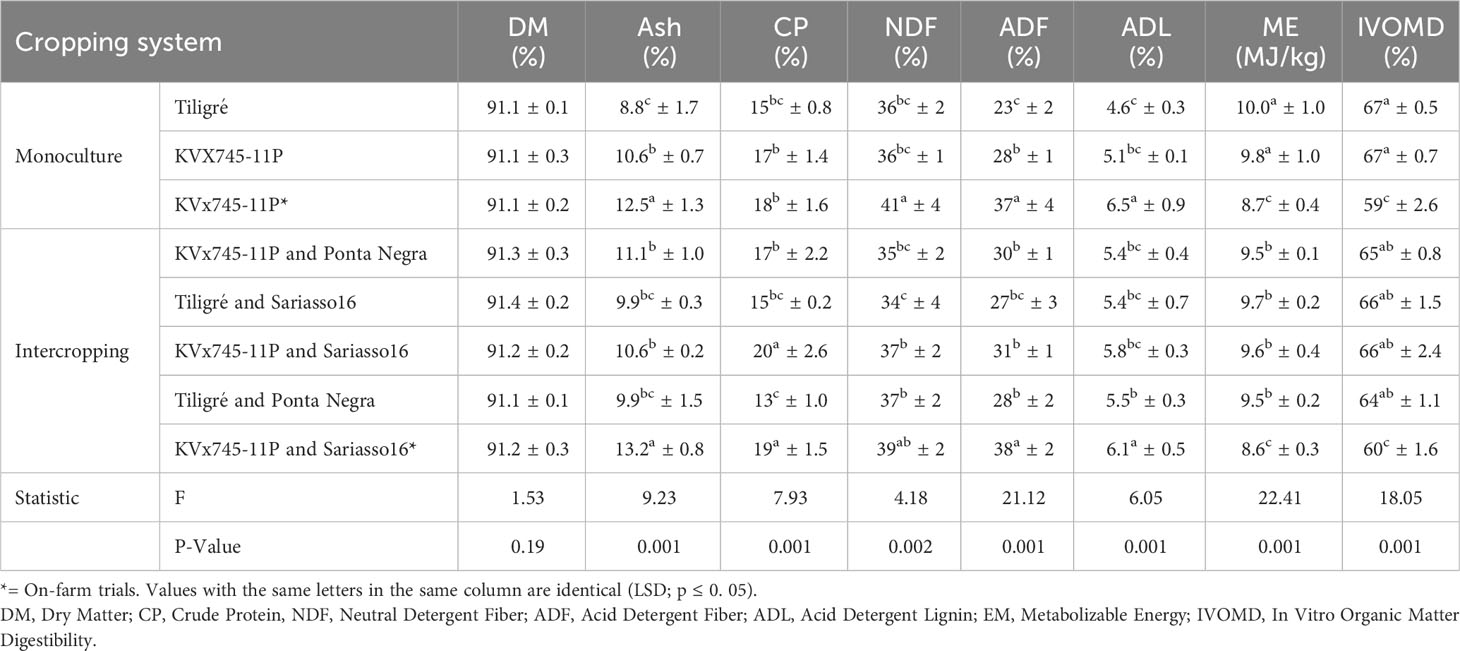
Table 9 Proximate composition and In vitro digestibility of the dry matter of cowpea haulms tested from the mother trial.
3.2 Discussion
3.2.1 Sorghum and cowpea intercropping reduced weed density and biomass
Cowpea and sorghum intercropping reduced weed density and biomass compared to sorghum monocultures. KVx745-11P was the most effective cowpea cultivar to improve weed control. Cowpea Tiligré was less effective, possibly because it is a semi-erect plant that also exhibits defoliation in the later stages of the reproductive period. This cultivar may be more sensitive to dry spells explaining the loss of leaves unfavorable to the process of smothering weeds (Ekeleme et al., 2019). Both sorghum cultivars were effective in controlling weeds, but Ponta Negra was somewhat more effective in relation to its great capacity to produce aerial biomass with large and long leaves that could play the role of smothering weeds. Allelopathy associated with competition for light, water, and mineral elements would influence weed photosynthesis, inducing a decrease in their growth (Kruk et al., 2006; Cordeau et al., 2015). Crop shading also creates unfavorable conditions for weed seed germination (Barro et al., 2016; Benider, 2018). Other authors also showed that cowpea intercropping with sorghum or maize reduced weed density and biomass compared to cereal monocultures and manual weeding (Bybee and Ryan, 2018; Ekeleme et al., 2019). Better weed control would lead to increased grain yield and fodder biomass and save time for plot weeding (Odhinambo and Ariga, 2001; Muhammad et al., 2013). Intercropping could therefore be an acceptable biological weed control approach in cropping systems instead of using chemical weed management strategies.
3.2.2 Grain yield and fodder biomass improvement
Sorghum Sariaso16, being a genetically improved grain type, had the greatest grain yield as expected. By comparison, Ponta Negra being a forage-type sorghum had the greatest fodder biomass. Those cultivars were selected as the best bet for this experiment based on prior research in Burkina Faso (Zampaligré et al., 2021). For cowpea, KVx745-11P and Tiligré had similar grain yield, while KVx745-11P fodder biomass was greater than for Tiligré, which is consistent with its spreading vegetative growth habit (Ramdé, 2019). The results are influenced by the combined effect of genetic, agro-climatic factors and various steps of crop management (Coulibaly et al., 2012; Alidu et al., 2013; Coulibaly et al., 2020; Ouédraogo et al., 2021). Some authors identified Sariaso16 and Ponta Negra as the best cultivars performing well in the North Sudan zone of Burkina Faso respectively for grain yield and fodder biomass even though yields were lower compared to the results presented in this study (Zampaligré et al., 2021).
These results highlight that the choice of cultivar by farmers would depend on their primary production objective (grain or biomass). Sariaso16 and cowpea KVx745-11P cultivars were locally developed at Saria (North Sudan zone of Burkina Faso) by INERA for food and food-feed purposes, respectively, even though Sariaso16 has acceptable fodder biomass (Kondombo, 2001; Palé, 2017; Zampaligré et al., 2021). Sorghum Ponta Negra (EMBRAPA-Brazil) and cowpea Tiligré (INERA) cultivars were released for fodder production and grain purposes, respectively, with more or less intermediate performances for food (Palé, 2017; Zampaligré et al., 2021).
This study was performed in the 2019 and 2020 cropping seasons which were wet years (rainfall deviating from the 1990-2020 series) (Figure 3). The genetic effect and pedo-climatic conditions influenced crop cultivar performance. Indeed, water and soil fertility which were the most limiting factors of crop production affected crop genetic potential (Alidu et al., 2013; Lalsaga and Drabo, 2017). Greater grain yield and fodder biomass were associated with rainy years, moderate temperatures, and normal rainfall distributions with better soil fertility conditions (Ishiyaku and Aliyu, 2013; Kihindo et al., 2015; Obulbiga et al., 2015). Hence, location-specific characteristics and production objectives were important in cultivar selection and recommendation (Zampaligré et al, 2021).
3.2.3 Sorghum and cowpea intercrop improves grain and fodder biomass yield
Sorghum and cowpea intercropping LERs for fodder biomass and grain yield were usually greater than one. This showed an advantage in terms of total production for intercropping. The capacity production of one sorghum stand grown with cowpea was higher than the one of sorghum or cowpea stands grown in monoculture. Thus, sorghum and cowpea intercropping would save 1 to 65% of land use for the overall production (grain and biomass) compared to the monoculture of each crop. This would lead to an increase in grain yield and fodder biomass in the same order of magnitude (Obulbiga et al., 2015; Akanza & N’guessan, 2017; Diatta et al., 2019). The SPI values for sorghum-cowpea intercropping were also higher than those of the corresponding sorghum monocultures in the intercropping (main crop). Then, the conversion of grain yield and fodder biomass of the secondary crop (cowpea) to the main crop (sorghum) in the intercropping are all higher than those of the corresponding sorghum monocultures. The best fodder biomass indexes (10539 and 12587) were obtained by the intercropping of Ponta Negra and KVx745-11P, respectively; Ponta Negra and Tiligré. For grain yield, the best values of SPI (4517 and 4883) are recorded respectively by the intercropping of Sariaso16 and KVx745-11P; Sariaso16 and Tiligré. These results showed the advantages of grain yield and fodder biomass production with sorghum-cowpea intercropping and were corroborated by other authors (Agegnehu et al., 2008; Khan et al., 2020). These comparative advantages can be explained by the beneficial relationships of complementarity between the two associated crops for the use of nitrogen resources, space (very different aerial architectures), and growth peaks (Justes et al., 2014; Barro et al., 2016; Louarn et al., 2016). Shifting the sowing date between the two associated crops reduces the interspecific competition (Mbaye et al. (2014). Indeed, the symbiotic fixation of atmospheric nitrogen by cowpeas limits its competition with sorghum, which uses mineral nitrogen in the soil. In addition, a greater interception of radiation and a reduction in weed incidence by intercropping could further explain these advantages (Muhammad et al., 2013). Sorghum and cowpea intercropping is a very efficient and appropriate cropping system to optimize fodder biomass production and grain yield for crop-livestock farmers.
3.2.4 Sorghum and cowpea nutritive value as fodder
Sorghum Sariaso16 fodder content of two anti-nutritional factors NDF and ADL was greater than those of Ponta Negra, implying a slightly better nutritive value for Ponta Negra. Sariaso16 and Ponta Negra both had similar CP regardless of the cropping system. The fodder of Ponta Negra had higher IVOMD than Sariaso16, regardless of the cropping system, confirming its higher nutritive value. In addition, fodder of sorghum Ponta Negra intercropped with Tiligré had greater ME content. For cowpea cultivars, KVx745-11P had the greatest content of ash and CP regardless of cropping systems. Intercropping also differentially affected cowpea fodder’s nutritive value for ash, ME, CP, and IVOMD. Finally, on-farm sorghum Sariaso16 and cowpea KVx745-fodder concentration in ash and ADF were greater than those on-station with the lowest content being ME. These results could be explained by the combined effect of genetic, agro-climatic factors and cropping systems (Cesar et al., 2009; Python and Boessinger, 2012; Mehdadi et al., 2013; Schlegel and Wyss, 2013; Louarn et al., 2016).
Cowpea KVx745-11P has better stay-green attributes at pod maturity with low leaf losses, resulting in greater CP content than many cultivars, which do not have these genetic characteristics (Obulbiga et al., 2015; Simian, 2017). Many cultivars of sorghum fodder showed variation of their CP content with ranges between 4.3 to 10.2%, (Simian, 2017; Zampaligré et al., 2021). This variability is mostly correlated to the harvest period; better CP concentration occurs during the heading phase and the CP begins to decline as the grains continue their maturation process (Simian, 2017). However, fodder cultivars such as Sariaso16 are more lignified with high concentrations of ADF and ash (Cesar et al., 2009). Some authors have shown that agro-ecological conditions and the duration time between fodder sample collection at farms and their pre-drying or drying would influence ash and crude cellulose content (Python and Boessinger, 2012; Mehdadi et al., 2013; Schlegel and Wyss, 2013). It has also been shown that cereal-legume intercropping would improve their total fodder quality in terms of protein and energy (Louarn et al., 2016). Sorghum fodder cultivars with CP concentration lower than 7% can be intercropped with cowpea in order to obtain an improved diet for livestock. Sorghum Ponta Negra intercropped with cowpea KVx745-11P would be the most appropriate cropping system for agro-pastoralists in Burkina Faso (livestock production as the main goal); whereas for crop-livestock farmers, it would be sorghum Sariaso16 intercropped with cowpea KVx745-11P (food production as the main goal).
For the extension of quality and quantity fodder production based on food-feed crops to meet human and livestock needs in Burkina Faso northern Sudan zone, we suggested emphasizing sorghum cultivar Ponta Negra and cowpea cultivar KVx745-11P intercropping and adoption of best fodder conservation technics in order to preserve fodder nutritive value for dry season utilization in Burkina Faso.
4 Conclusions
Sorghum and cowpea intercropping with improved cultivars resulted in optimized grain and fodder biomass production while effectively controlling weeds when compared to monoculture of either sorghum or cowpea. For intercropping systems, sorghum cultivar Ponta Negra and cowpea cultivars had the greatest fodder production whereas sorghum cultivar Sariaso16 and cowpea cultivars had the greatest grain yields. The two cultivars of sorghum had similar fodder nutritive value in terms of ash, CP, and ME although Ponta Negra had higher IVOMD and lower ADF. Cowpea KVx745-11P fodder nutritive value was the best for ash, CP, and ADF content. Sorghum-Cowpea intercropping differentially affected fodder nutritive value in terms of ash, ME, CP, and IVOMD. In summary, intercropping was more efficient and appropriate for fodder biomass and grain yield compared to monoculture with equivalent or better fodder quality.
Data availability statement
The original contributions presented in the study are included in the article/supplementary material. Further inquiries can be directed to the corresponding author.
Author contributions
SA: Contribution to study’s conceptual and methodological design, as well as first manuscript drafting, revision, and editing. ZN: Contribution to study’s conceptual and methodological design, as well as first manuscript drafting, revision, editing, and country project coordination. KA: Contribution to study’s conceptual and methodological design, as well as manuscript revision and editing; this PhD research supervisor. DJ and OA: Contributed to data collection and curation. RF, DJ, JB, and BK: Contributed to the study’s conceptual and methodological design, as well as manuscript revision and editing. AA: Contributed to manuscript revision and editing, project coordination, and fundraising. All authors contributed to the article and approved the submitted version.
Funding
The author(s) declare financial support was received for the research, authorship, and/or publication of this article. This work was funded in whole or part by the United States Agency for International Development (USAID) Bureau for Resilience and Food Security under Agreement # AID-OAA-L-15-00003 as part of Feed the Future Innovation Lab for Livestock Systems. Additional funding was received from the Bill & Melinda Gates Foundation OPP#1175487. Any opinions, findings, conclusions, or recommendations expressed here are those of the authors alone. Under the grant conditions of the Foundation, a Creative Commons Attribution 4.0 Generic License has already been assigned to the Author Accepted Manuscript version that might arise from this submission.
Conflict of interest
The authors declare that the research was conducted in the absence of any commercial or financial relationships that could be construed as a potential conflict of interest.
Publisher’s note
All claims expressed in this article are solely those of the authors and do not necessarily represent those of their affiliated organizations, or those of the publisher, the editors and the reviewers. Any product that may be evaluated in this article, or claim that may be made by its manufacturer, is not guaranteed or endorsed by the publisher.
References
Abera A., Mekonnen K., Duncan A. J., Kamal S., Ergano K., Thorne P., et al. (2021). Redesigning traditional weed management practices in faba bean production to optimize food-feed production in the smallholder system. Agron. J., 248–258. doi: 10.1002/agj2.20779
Agegnehu G., Ghizaw A., Sinebo W. (2008). Yield potential and land-use efficiency of wheat and faba bean mixed intercropping. Agron. Sustain. Dev. 28 (2), 257–263. doi: 10.1051/agro:2008012
Akakpo D. B., de Boera I. M., Adjei-Nsiahc S., Duncand A. J., Giller K. E., Oosting S. J. (2020). Evaluating the effects of storage conditions on dry matter loss and nutritional quality of grain legume fodders in West Africa. Anim. Feed Sci. Technol. 262. doi: 10.1016/j.anifeedsci.2020.114419
Akanza K. P., N’guessan N. E. (2017). Performances agronomique et économique des systèmes de culture à base de maïs (Zea mays L.) et d’arachide (Arachis hypogaea L.) au nord de la Côte d'Ivoire Vol. 5 (REV. CAMES).
Alidu M. S., Atokple I. D., Akromah R. (2013). Genetic analysis of vegetative-stage drought tolerance in cowpea. Greener J. Agric. Sci. 3 (6), 481–496. doi: 10.15580/GJAS.2013.3.030613516
Amole T., Ayantunde A. A. (2016). Improving livestock productivity: Assessment of feed resources and livestock management practices in Sudan-Savanna zones of West Africa. Afr. J. Agric. Res. 11, 422–440. doi: 10.5897/AJAR2015.10460
Barro A., Sangaré M., Coulibaly K., Koutou M., Diallo M. A. (2016). Etude des modalités d’association maïs/niébé dans les villages de Koumbia et Gombêlêdougou en zone cotonnière de l’Ouest du Burkina Faso. Sci. Technique Spécial hors-série, 151–163.
Bayala J., Ky-Dembele C., Kalinganire A., Olivier A., Nantoume H. (2014). A review of pasture and fodder production and productivity for small ruminants in the Sahel (Nairobi: ICRAF/World agroforestery Center).
Beck H. E., Zimmermann N. E., McVicar R. T., Vergopolan N., Berg N. A., Wood F. E. (2018). Present and future Köppen-Geiger climate classification maps at 1-km resolution. Sci. Data 5. doi: 10.1038/sdata.2018.214
Benider C. (2018). Performances de l’association céréales-légumineuses en systèmes fourragers des régions semi-arides (Algérie). thèse de doctorat en biologie végétale Vol. 1 (Université Ferhat Abbas Sétif).
Boote J. K., Adesogan T. A., Balehegn M., Duncan A., Muir P. J., Dubeux C. J. Jr., et al. (2021). Fodder development in Sub-Saharan Africa: an introduction. Agron. J. 114, 1–7. doi: 10.1002/agj2.20924
Bybee K. A., Ryan M. R. (2018). Advancing intercropping research and practices in industrialized agricultural landscapes. Agriculture 8, 80–96. doi: 10.3390/agriculture8060080
Cesar J., Guiro A. (2004). Les légumineuses fourragères ‘herbacées. Production animale en Afrique de l’Ouest. Fiche technique NO 7 (Bobo-Dioulasso: CIRDES).
Cesar J., Kanwe A., Zongo L., Akoudjim M. (2009). EXPERIMENTATIONS EN CULTURES FOURRAGERES dans la region de Bobo-Dioulasso (Bobo-Dioulasso: CIRDES - Urpan/CIRAD).
Cordeau S., Guillemin J. P., Reibel C., Chauvel B. (2015). Weed species differ in their ability to emerge in no-till systems that include cover crops. Ann. Appl. Biol. 166, 444–455. doi: 10.1111/aab.12195
Coulibaly Z., Barro A., Tignegré J. B., Kiébré Z. (2020). Évaluation des performances agronomiques de douze (12) variétés de niébé vert [Vigna unguiculata (L.) walp.] au Burkina Faso. J. Appl. Biosci. 153, 15745–15755.
Coulibaly K., Gomgnimbou A. P., Traore M., Nacro H. B., Sédogo M. (2017). Effets des associations maïs-légumineuses sur le rendement du maïs (Zea mays L.) et la fertilité d’un sol ferrugineux tropical à l’Ouest du Burkina Faso. Afrique Sci. 13 (6), 226–235. doi: 85597201
Coulibaly K., Vall E., Autfray P., Sedogo P. M. (2012). Performance technico-économique des associations maïs-niébé et maïs-mucuna en situation réelle de culture au Burkina Faso: potentiels et contraintes. Tropicultura 30 (3), 147–154. doi: 10.35759/JABS.153.2
Cuvelier C., Dufrasne I. (2014). L’alimentation de la vache laitière: Aliments, calculs de ration, indicateurs d’évaluation des déséquilibres de la ration et pathologies d’origine nutritionnelle. Livret de l’agriculteur (Liège: Université de Liège). 105p.
Diatta A. A., Abaye O., Thomason W. E., Modou L. O., Guèye F., Baldé A. B., et al. (2019). Effet de l’association du haricot mungo sur le rendement du mil dans le Bassin arachidier. Innov. Agronomiques 74, 69–81. doi: 10.15454/T7GWAX
Duncan A. J., Bachewe F., Mekonnen K., Lule D., Bahta M., Erenstein O. (2016). Crop residue allocation to livestock feed, soil improvement and other uses along a productivity gradient in East Africa. Agric. Ecosyst. Environ. 228, 101–110. doi: 10.1016/j.agee.2016.05.011
Ekeleme F., Atser G., Dixon A., Hauser S., Chikoyé D., Olorunmaiye P. M., et al. (2019). Assessment of weeds of cassava and farmers mannagement practices in Nigeria. Tropicultura 37 (2), 12–25.
FAO (2014). Résidus agricoles et sous-produits agro-industriels en Afrique de l’ouest: état des lieux et perspectives pour l’élevage (Accra: Bureau Régional pour l’Afrique de la FAO). 73P.
Feyissa F., Prasad S., Assefa G., Bediye S., Kitaw G., Kehaliew A., et al. (2014). Dynamics in nutritional characteristics of natural pasture hay as affected by harvesting stage, storage method and storage duration in the cooler tropical highlands. Afr. J. Agric. Res. 9, 3233–3244. doi: 10.5897/AJAR2014.8652
Gonsalves J., Becker T., Braun A., Campilan D., de Chavez H., Fajber E., et al. (2005). Participatory research and development for sustainable agriculture and natural resource management: A sourcebook. Volume 2: enabling participatory research and development (Laguna, Philippines; Ottawa, Canada: International Potato Center-Users’ Perspectives With Agricultural Research and Development and International Development Research Centre).
Ilboudo M. (2020). Optimisation de la production fourragère à base d’association culturale de variétés améliorées de sorgho et d’arachide à double usage dans la zone Nord Soudanienne du Burkina Faso (Bobo Dioulasso: Mémoire de fin de cycle/Université Nazi Boni-IDR).
Ishiyaku M. F., Aliyu H. (2013). Field evaluation of cowpea genotypes for drought tolerance and Striga resistance in the dry savanna of north-west Nigeria. Int. J. Plant Breed. Genet. 7 (1), 47–56.
Justes E., Bedoussac L., Corre-Hellou G., Fustec J., Hinsinger P., Pelzer E. (2014). Les processus de complémentarité de niche et de facilitation déterminant le fonctionnement des associations végétales et leur efficacité pour l’acquisition des ressources abiotitiques. Innov. agronomiques 40, 1–24.
Kagoné H. (2001). Profil fourrager – Burkina Faso (Rome, Italie: FAO). Available at: https://docplayer.fr/51588104-Profil-fourrager-burkina-faso-par-dr-ir-hamade-kagone.html.
Khan M. N., Shoaib M., Ashraf M. S., Qamar R., Mahboob A., Ijaz S. (2020). Mungbean (Vigna radiata) intercropping enhances productivity of late season irrigated cotton in Punjab. Asian J. Agric. Biol. 8 (4), 472–479. doi: 10.35495/ajab.2020.03.187
Kiéma A. (2008). Effets des techniques de restauration et d’exploitation des pâturages naturels sahéliens sur la dynamique de la production fourragère (Bobo-Dioulasso: Université Polytechnique de Bobo-Dioulasso).
Kiéma A., Bambara G. T., Zampaligré N. (2019). Transhumance et gestion des ressources naturelles au Sahel: contraintes et perspectives face aux mutations des systèmes de productions pastorales Vol. 14 (La revue électronique en sciences de l’environnement).
Kihindo A. P., Bazie R. H., Ouedraogo R. F., Somé P. P., Zombré G., Tozo K. (2015). Effets de la date de semis et du régime hydrique sur la réponse agro morphologique de deux variétés de niébé (KN1 ET KVX 61-1) au Burkina Faso. lntrenational J. Innovation Appl. Stud. 12 (3), 564–573.
Kondombo C. P. (2001). Evaluation agronomique et fourragère de 194 lignées recombinantes de sorgho. Mémoire de fin de cycle d’Ingénieur du Développement Rural, option: Agronomie (Burkina Faso: Institut du développement rural, Université polytechnique de Bobo Dioulasso). 89p.
Kristjanson P., Neufeldt H., Gassner A., Mango J., Kyazze B. F., Desta S., et al. (2012). Are food insecure smallholder households making changes in their farming practices? Evidence East Africa Food Secur. 4 (3), 381–397. doi: 10.1007/s12571-012-0194-z
Kruk B., Insausti P., Razul A., Benech-Arnold R. (2006). Light and thermal environments as modified by a wheat crop: effects on weed seed germination. J. Appl. Ecol. 43, 227–236. doi: 10.1111/j.1365-2664.2006.01140.x
Lalsaga W. J., Drabo I. (2017). Évaluation de quinze génotypes de niébé [Vigna unguiculata (L.) Walp.] sous conditions pluviales dans le Nord et le Centre Ouest du Burkina Faso. Int. J. Biol. Chem. Sci. 11 (6), 2756–2763. doi: 10.4314/ijbcs.v11i6.16
Louarn G., Faverjon L., Bijelić Z., Julier B. (2016). Dynamique de l’azote dans les associations graminées -légumineuses: quels leviers pour valoriser l’azote fixé? Fourrages Fourrages 226, 135–142.
MA (2015). Resultats definitifs de la campagne agricole 2014/2015 et perspectives de la situation alimentaires et nutritionelle (Ouagadougou: Ministère de l’agriculture).
Matusso J. M., Mugwe J. N., Mucheru-Muna M. (2014). Potential role of cereal-legume intercropping systems in integrated soil fertility management in smallholder farming systems of Sub-Saharan Africa. Res. J. Agric. Environ. Manage. 3 (3), 162–174. doi: 46301268
Mbaye M. S., Gueye M., Bassence C., Ba N., Diop D., Sylla S. N., et al. (2014). Date et densité optimales de semis du niébé [Vigna unguiculata (L.) Walp.] en association avec le mil [Pennisetum glaucum (L.) R. Br.]. J. Appl. Biosci. 76, 6305–6315. doi: 10.4314/jab.v76i1.4
Mehdadi Z., Benaouda Z., Latreche A., Benhassaini H., Belbraouet S. (2013). Évolution saisonnière de la composition foliaire de Stipa tenacissima L. en éléments minéraux et en fibres pariétales. Acta Botanica Gallica 155 (3), 435–445. doi: 10.1080/12538078.2008.10516123
MRSI (2014). Catalogue national des espèces et variétés agricoles du Burkana Faso (Ouagadougou: MASA/MEDD).
Muhammad A. K., Khan B. M., UMM E. K., Zahid H., Saima H., Abdur R., et al. (2013). Weed contol effects on Wheat-Pea intercropping. Pak. J. Bot. 45 (5), 1743–1748.
Mulumba J. B., Somda J., Sanon Y., Kagoné H. (2008). Elevage et marché régional au Sahel et en Afrique de l’Ouest (Potentialités et défis. CSAO/OCDE/CEDEAO). 163 p.
Nantoumé H., Kouriba A., Togola D., Ouologuem B. (2000). Mesure de la valeur alimentaire des fourrages et sous-produits utilisés dans l’alimentation des petits ruminants. Rev. d’Elevage Médicine Vétérinaire Des. Pays Tropicaux 53, 279–284.
Nasir I., Sajad H., Zeeshan A., Feng Y., Xiaochun W., Weiguo L., et al. (2019). Comparative analysis of maize–soybean strip intercropping systems. Plant Production Sci. 22 (2), 131–142.
N’Goran K. E., Kaassin K. E., Zohouri G. P., N’Gbesso M. F., Yoro G. R. (2011). Performances agronomiques des associations culturales igname légumineuses alimentaires dans le Centre- Ouest de Côte d’Ivoire. J. Appl. Biosci. 43, 2915–2923.
Obulbiga M. F., Bougouma V., Sanon O. H. (2015). Amélioration de l’offre fourragère par l’association culturale céréale-légumineuse à double usage en zone nord soudanienne du Burkina Faso. Int. J. Biol. Chem. Sci. 9 (3), 1431–1439. doi: 10.4314/ijbcs.v9i3.26
Odhinambo G. D., Ariga E. S. (2001). Effet of intercropping maize and bean on striga incidence and grain yield. Seventh Eastern South. Afr. Rrgional Maize Conf., 183–186.
Ouédraogo S. (2019). Performances agronomiques et fourragères des variétés améliorées de Sorgho à double usage en zone nord soudanienne du Burkina Faso (Bobo Dioulasso: Mémoire de fin de cycle. Université Nazi Boni-IDR).
Ouédraogo N., Thio G. I., Sanou A., Kouraogo I., Barro O., Sawadogo1 A. P., et al. (2021). Agronomic performance and adaptability study of New Guinea lines in Sudanian and Sudano-sahelian zones. J. Appl. Biosci. 167, 17320–17334.
Palé K. (2017). Evaluation des performances agronomiques de cinq lignées de niébé et de leurs qualités fourragères à la Station expérimentale de Saria, Burkina Faso (Dedougou: IISEDR-CUPD).
Python P., Boessinger M. (2012). Facteurs d’influence sur les valeurs nutritives des fourrages secs ventilés/Production végétale. Recherche Agronomique Suisse 3 (1), 36–43.
Ramdé A. (2019). Performances agronomiques et fourragères de variétés améliorées de niébé (Vigna unguiculata (L.) Walpers) à double usage dans les zones agro écologiques du Burkina Faso (Université Ouaga1 Pr. Joseph Ki Zerb: Mémoire de fin de cycle. ISEDR).
Rusike J. S., Snapp S. S., Twomlow S. (2004). Mother-Baby trial approach for developing soil water and fertility management technologies. Volume 2 (Lima, Peru: Field Tested Practices in Participatory Research and Development International Potato Center (CIP-UPWARD).
Sanfo A., Savadogo I., Kulo E. A., Zampaligre N. (2015). Climate change: A driver of crop farmers and agro-pastoralists conflicts in Burkina Faso. Int. J. Appl. Sci. Technol. 5 (3), 92–104. doi: 10.35759/JAnmPlSci.v46-3.4
Sanfo A., Zampaligré N., Kulo E. A. (2020). Analyse des préférences des agropasteurs pour la production et la conservation du fourrage à base devariétés améliorées de cultures à double objectifs dans deux zones agro-écologiques au Burkina Faso. J. Anim. Plant Sci. 46 (3), 8318–8335.
Sanfo A., Zampaligré N., Kulo A. E., Somé S., Traoré K., Rios E. F., et al. (2023). Performance of food–feed maize and cowpea cultivars under monoculture and intercropping systems: Grain yield, fodder biomass, and nutritive value. Front. Anim. Sci. 3, 998012. doi: 10.3389/fanim.2022.998012
Sanou K. F., Nacro S., Ouédraogo M., Ouédraogo S., Kaboré-Zoungrana C. (2011). La commercialisation de fourrages en zone urbaine de Bobo-Dioulasso (Burkina Faso): pratiques marchandes et rentabilité économique. Cah Agric. 20, 487–493. doi: 10.1051/cagri/2016007
Schlegel P., Wyss Y. ,. U. (2013). Teneur en oligo-éléments des fourrages. Renc. Rech. Ruminants 20, 45–48.
Simian A. (2017). Production et valeur alimentaire des résidus de culture des variétés à double objectifs utilisés dans l’alimentation animale dans la province du Yatenga (Bobo Dioulasso: Mémoire de fin de cycle. Université Nazi Boni-IDR).
Snapp S. (2002). “Quantifying farmer evaluation of technologies: the mother and baby trial design,” in Quantitative analysis of data from participatory methods in plant breeding. Ed. Bellon D. M.a. (Mexico, DF: CIMMYT).
Somda J. (2001). Performances zootechniques et rentabilité financière des ovins en embouche au Burkina Faso. Biotechnol. Agron. Soc Environ. 5 (2), 73–78.
Traoré S. H. (2012). Etude des inlpacts agro-pédologiques des apports continus et en rotation de fertilisants organo-minéraux sur le cotonnier en stations de recherche : cas de Sana et Farako-Bâ. Bobo-Dioulasso: IDR-Université polytechnique de Bobo-Dioulasso.
Willey R. W. (1979). Intercropping—It’s Important and Research Needs. Part 1. Competition and Yield Advantages. Field Crop Abstracts 32, 1–10.
Zampaligré N., Dossa H. L., Schlecht E. (2013). Contribution of browse to ruminant nutrition across three agro-ecological zones of Burkina Faso. J. Arid Environments 95, 55–64. doi: 10.1016/j.jaridenv.2013.03.011
Keywords: crop-livestock system, cowpea, burkina faso, food-feed crops, sorghum
Citation: Abroulaye S, Nouhoun Z, Jethro DB, Abalo KE, Abdoulaye O, Esteban F. R, José D, Ken BJ and Adegbola A (2023) Sorghum [Sorghum bicolor (L.) Moench] and cowpea [Vigna unguiculata (L.) Walpers] intercropping improves grain yield, fodder biomass, and nutritive value. Front. Anim. Sci. 4:1233570. doi: 10.3389/fanim.2023.1233570
Received: 02 June 2023; Accepted: 07 November 2023;
Published: 11 December 2023.
Edited by:
Marcos Inacio Marcondes, Washington State University, United StatesReviewed by:
Marketta Rinne, Natural Resources Institute Finland (Luke), FinlandJuana Catarina Cariri Chagas, Swedish University of Agricultural Sciences, Sweden
Copyright © 2023 Abroulaye, Nouhoun, Jethro, Abalo, Abdoulaye, Esteban F., José, Ken and Adegbola. This is an open-access article distributed under the terms of the Creative Commons Attribution License (CC BY). The use, distribution or reproduction in other forums is permitted, provided the original author(s) and the copyright owner(s) are credited and that the original publication in this journal is cited, in accordance with accepted academic practice. No use, distribution or reproduction is permitted which does not comply with these terms.
*Correspondence: Sanfo Abroulaye, z.nouhoun@ufl.edu
 Sanfo Abroulaye1,2*
Sanfo Abroulaye1,2*  Zampaligré Nouhoun
Zampaligré Nouhoun Rios Esteban F.
Rios Esteban F. Boote J. Ken
Boote J. Ken Adesogan Adegbola
Adesogan Adegbola